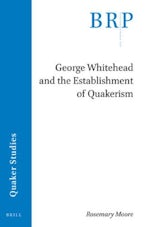- Home
- Brill Research Perspectives in Quaker Studies
- religion
- history
- George Whitehead and the Establishment of Quakerism

George Whitehead and the Establishment of Quakerism
By: Rosemary Moore
Series: Brill Research Perspectives in Quaker Studies
132 Pages
George Whitehead and the Establishment of Quakerism, a modest 124-page booklet may not be the precise volume that Quakers, scholars, and students of the Religious Society of Friends have been awaiting since George Whitehead died in 1723, but it will have to do for now. Its author, the English scholar Rosemary Moore, is one of the most accomplished authorities on early Quaker history, has produced a fine introduction to one of the most important—and nearly forgotten!—first Friends. Sources for his life are thin indeed, mostly published theological works, but Moore has made the most of them to offer us and future explorers a roadmap of what is needed for a more complete picture.
For those interested in religious history, moreover, this is a volume that transcends Quakerism, even as it relates an interesting and important sectarian story. It should prove valuable to those interested in how historical writing proceeds, what to do when one has only limited sources, and how to go about filling the gaps that remain after the sources have been carefully mined to the fullest extent possible. Moore takes her readers by the hand and leads them into places where they can make sensible estimates of what the sources are revealing and implying. Lots of people beyond Quakers will benefit from the work of this informed guide.
Born in 1636 in the isolated village of Sunbiggin in present day Cumbria, an area from which many early Friends originated, Whitehead became a Friend in 1652 and remained active until his death seventy-one years later. During all that time, he knew and collaborated with the leaders of the movement he had joined and proved a moderating force among what was initially a group interested in, to borrow a phrase from historian Christopher Hill, turning the world upside down. His faith was more Christian-oriented, his political activity beyond Quakerism was mostly restricted to seeking religious tolerance for members of his sect, and he devoted himself to seeing that numerous internal conflicts among Friends did no lasting damage to the presbyterian-like governance he worked so hard to prefect for Friends in the 1670s. His written works, most importantly his memoir, may merit the commonly used adjectives “dull” and “uninspiring,” but his importance for the survival of the Religious Society of Friends can hardly be gainsaid.
Moore’s knowledge of the Quaker sources adds weight to her conjectures about Whitehead’s relationships with powerful Friends like George Fox, William Penn, and Alexander Parker. His steady and important support of Fox’s system of governance certainly placed him in the top ranks of Friendly leadership, one of the reasons that 17th Century dissident Friends who left the Society, like George Keith and Francis Bugg, continued to attack him into the next century.. He outlived the former and almost the latter of these critics and oversaw the survival of Quakers as an organized body. This longitivity testifies to Whitehead’s continuing significance and the value of Moore’s too-brief introduction to his career. (At least twice Moore assures her readers that the onset of the Covid-19 pandemic prevented her from executing the broader and necessary research she intended originally.) She has offered many wise words from which her readers will benefit. The volume will occupy a permanent and oft-used place in my library, as it will undoubtedly do in those of others. It should also prove extremely valuable to the relatively invisible evangelical wing of the Quaker movement, those who are in fact numerically the largest body of modern Friends, despite their aversion to history, even their own. So I trust the book will be widely read.
Larry Ingle is an emeritus professor of history at the University of Tennessee-Chattanooga.
Larry IngleDate Of Review:January 31, 2023
Rosemary Moore, Ph.D. (1993) University of Birmingham. Honorary staff member, Centre for Research in Quaker Studies. Author of The Light in Their Consciences: Early Quakers in Britain 1646-1666 (Penn State University Press, 2000, revised edition 2020) and other publications on early Quakerism.











